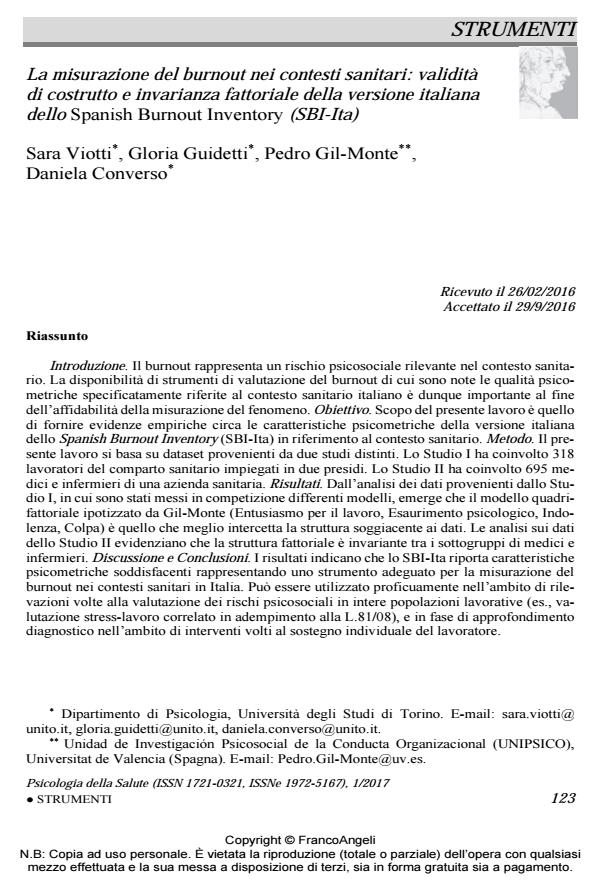La misurazione del burnout nei contesti sanitari: validità di costrutto e invarianza fattoriale della versione italiana dello Spanish Burnout Inventory (SBI-Ita)
Titolo Rivista PSICOLOGIA DELLA SALUTE
Autori/Curatori Sara Viotti, Gloria Guidetti, Pedro Gil-Monte, Daniela Converso
Anno di pubblicazione 2017 Fascicolo 2017/1
Lingua Italiano Numero pagine 22 P. 123-144 Dimensione file 299 KB
DOI 10.3280/PDS2017-001007
Il DOI è il codice a barre della proprietà intellettuale: per saperne di più
clicca qui
Qui sotto puoi vedere in anteprima la prima pagina di questo articolo.
Se questo articolo ti interessa, lo puoi acquistare (e scaricare in formato pdf) seguendo le facili indicazioni per acquistare il download credit. Acquista Download Credits per scaricare questo Articolo in formato PDF

FrancoAngeli è membro della Publishers International Linking Association, Inc (PILA)associazione indipendente e non profit per facilitare (attraverso i servizi tecnologici implementati da CrossRef.org) l’accesso degli studiosi ai contenuti digitali nelle pubblicazioni professionali e scientifiche
Introduzione. Il burnout rappresenta un rischio psicosociale rilevante nel contesto sanitario. La disponibilità di strumenti di valutazione del burnout di cui sono note le qualità psicometriche specificatamente riferite al contesto sanitario italiano è dunque importante al fine dell’affidabilità della misurazione del fenomeno. Obiettivo. Scopo del presente lavoro è quello di fornire evidenze empiriche circa le caratteristiche psicometriche della versione italiana dello Spanish Burnout Inventory (SBI-Ita) in riferimento al contesto sanitario. Metodo. Il presente lavoro si basa su dataset provenienti da due studi distinti. Lo Studio I ha coinvolto 318 lavoratori del comparto sanitario impiegati in due presidi. Lo Studio II ha coinvolto 695 medici e infermieri di una azienda sanitaria. Risultati. Dall’analisi dei dati provenienti dallo Studio I, in cui sono stati messi in competizione differenti modelli, emerge che il modello quadri-fattoriale ipotizzato da Gil-Monte (Entusiasmo per il lavoro, Esaurimento psicologico, Indolenza, Colpa) è quello che meglio intercetta la struttura soggiacente ai dati. Le analisi sui dati dello Studio II evidenziano che la struttura fattoriale è invariante tra i sottogruppi di medici e infermieri. Discussione e Conclusioni. I risultati indicano che lo SBI-Ita riporta caratteristiche psicometriche soddisfacenti rappresentando uno strumento adeguato per la misurazione del burnout nei contesti sanitari in Italia. Può essere utilizzato proficuamente nell’ambito di rilevazioni volte alla valutazione dei rischi psicosociali in intere popolazioni lavorative (es., valutazione stress-lavoro correlato in adempimento alla L.81/08), e in fase di approfondimento diagnostico nell’ambito di interventi volti al sostegno individuale del lavoratore.
Parole chiave:Spanish Burnout Inventory (SBI), medici, infermieri, analisi fattoriale confermativa (CFA), invarianza fattoriale
- Work Satisfaction and Its Relationship with Burnout and Its Consequences, Using a Structural Model, in Air Cabin Crew Members Dáilet Fredes-Collarte, Víctor Olivares-Faúndez, José Carlos Sánchez-García, Jenniffer Peralta Montecinos, in Sustainability /2024 pp.9619
DOI: 10.3390/su16229619 - Feeling Guilty or Not Guilty. Identifying Burnout Profiles among Italian Teachers Gloria Guidetti, Sara Viotti, Pedro R. Gil-Monte, Daniela Converso, in Current Psychology /2018 pp.769
DOI: 10.1007/s12144-016-9556-6 - We cannot be “forever young,” but our children are: A multilevel intervention to sustain nursery school teachers’ resources and well-being during their long work life cycle Ilaria Sottimano, Gloria Guidetti, Daniela Converso, Sara Viotti, Leonidas G Koniaris, in PLOS ONE /2018 pp.e0206627
DOI: 10.1371/journal.pone.0206627 - I’ll Be a Caregiver-Employee: Aging of the Workforce and Family-to-Work Conflicts Daniela Converso, Ilaria Sottimano, Sara Viotti, Gloria Guidetti, in Frontiers in Psychology 246/2020
DOI: 10.3389/fpsyg.2020.00246 - When social support by patrons protects against burnout: A study among Italian public library workers Mara Martini, Sara Viotti, Daniela Converso, Jolanda Battaglia, Barbara Loera, in Journal of Librarianship and Information Science /2019 pp.1091
DOI: 10.1177/0961000618763716 - Psychometric Properties of the Spanish Burnout Inventory in University Teachers in Hybrid Education Angel Deroncele-Acosta, Pedro R. Gil-Monte, Roger P. Norabuena-Figueroa, Pedro Gil-LaOrden, in Chronic Stress 24705470231214950/2023
DOI: 10.1177/24705470231214950
Sara Viotti, Gloria Guidetti, Pedro Gil-Monte, Daniela Converso, La misurazione del burnout nei contesti sanitari: validità di costrutto e invarianza fattoriale della versione italiana dello Spanish Burnout Inventory (SBI-Ita) in "PSICOLOGIA DELLA SALUTE" 1/2017, pp 123-144, DOI: 10.3280/PDS2017-001007